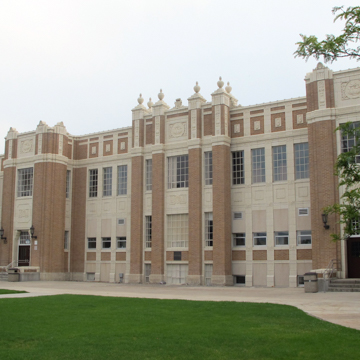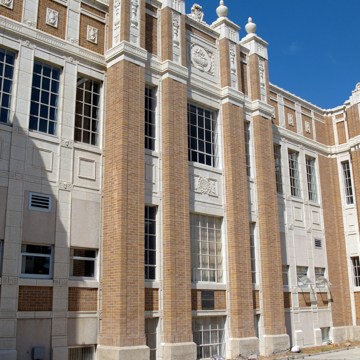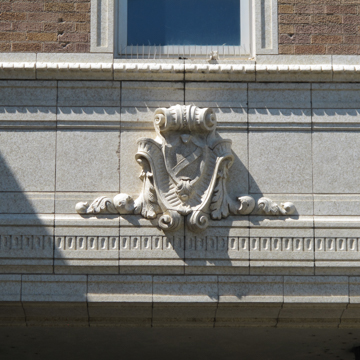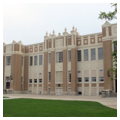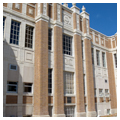Pocatello’s first high school was built in 1892 and originally served all grades from first through twelve. The imposing three-story, Richardsonian Romanesque building burned to the ground in 1914 and was rebuilt under the design and guidance of Frank H. Paradice, who had recently moved to Pocatello from Boise. The new high school continued with a more moderate version of rusticated stone and followed the basic three-part design of the original building. As Pocatello grew along with the railroad, the needs of the high school also increased and officials again turned to Paradice to oversee a remodeling and expansion. The result was a grand school facility built with WPA funds on two city blocks between Garfield and Arthur Streets. A new auditorium and gymnasium were added to the campus in an adjoining block. Paradice used a golden brown brick with extensive cream-colored, terra-cotta ornamentation on the facade of the new building—a decorative tour de force.
At the time of the remodeling, Paradice was sixty years old and had been practicing for more than thirty years. He had designed Pocatello’s first terra-cotta building, the Franklin Building, in 1915 and had been honing his terra-cotta expertise in a series of commissions. In 1937 he completed the new Montpelier High School, which, in many ways, set the standard for Pocatello’s new school. Paradice made extensive use of glass in the high school’s large windows, at once Elizabethan and industrial, with carefully articulated terra-cotta spandrels and large mullions. (Many of these windows have since been reconfigured in an effort to conserve energy.) The entire building has a beautiful cornice cap using both brick and cream-colored terra-cotta. The central panel of the courtyard is capped off with a series of six fruit bowl motifs, emphasizing Paradice’s sculptural skills.
Pocatello High School is one of the largest urban high schools in Idaho and one of the few in the state that continues to serve its original city district.
References
Attebery, Jennifer Eastman. Building Idaho, An Architectural History. Moscow: University of Idaho Press, 1991.
Attebery, Jennifer Eastman, and Terrance W. Epperson, “Pocatello Historic District,” Bannock County, Idaho. National Register of Historic Places Inventory–Nomination Form, 1982. National Park Service, U.S. Department of the Interior, Washington, DC.
Mallette, Walter P. and Lance J. Holladay. Images of America Pocatello. Charleston, S.C: Arcadia Publishing, 2013.
Neil, J. Meredith. Saints and Oddfellows, A Bicentennial Sampler of Idaho Architecture. Boise, ID: Boise Gallery of Art Association, 1976.
Nielson, Nick. Francis Henry Paradice Jr., A Pioneer in Pocatello Architecture. Unpublished paper, 2015.

